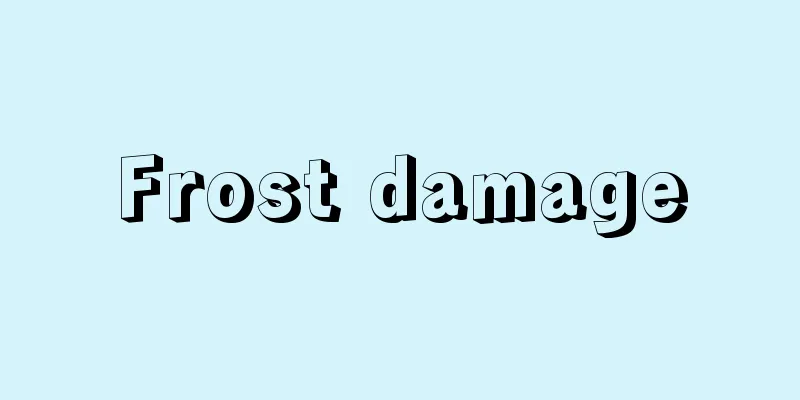Frost damage

|
A phenomenon in which temperatures suddenly drop in early summer or late fall, causing damage to crops and fruit trees. Early summer damage is called late frost damage, and late fall damage is called first frost damage. Although it is called frost damage, it is not the frost itself that causes the damage; rather, the low temperatures that cause frost cause the moisture inside or outside of the cells of crops to freeze, dehydrating the cells and causing them to die, so mechanically it is the same as cold damage or frost damage. Frost damage is also sometimes called freeze damage. In early summer or late autumn, cold air from the continent arrives over Japan accompanied by a mobile high pressure system, causing radiative cooling that results in abnormally low temperatures at dawn. The extent of damage varies depending on the state of growth of the young buds of crops and fruit trees at the time, but frost damage generally occurs when the outdoor temperature drops below 4°C. Late frost damage is not expected to occur after the 88th night (around May 2nd), but in the Tohoku region and highland areas, there is a risk of frost until around mid-May, and there are records of frosts occurring in Hokkaido as early as June. To prevent frost damage, the weather bureaus' frost warnings can be used to predict low temperatures at dawn and prevent the temperature from dropping due to radiation cooling. Methods for this include the smoking method (burning wet straw or old tires to create a smoke screen), heating method, and blowing air, but if the area is small, straw mats can be used instead. A special method is to spray water on the crops to form ice on their surface. [Takao Ando] [Reference] |Source: Shogakukan Encyclopedia Nipponica About Encyclopedia Nipponica Information | Legend |
|
初夏または晩秋に、気温が急に低下して、農作物や果樹に被害を与える現象。初夏のものを晩霜害、晩秋のものを初霜害という。霜害といっても、霜が直接被害を与えるわけではなく、霜が降りるほどの低温によって、農作物の細胞の内または外の水分が凍り、そのために細胞は奪水されて枯死するので、機構的には寒害または凍害と同じである。霜害のことを凍霜害ということもある。 初夏または晩秋に、大陸から寒気が移動性の高気圧に伴って日本上空に来襲し、放射冷却によって明け方異常な低温となることがその原因である。そのときの作物や果樹の若芽の成長の程度で被害は異なるが、だいたい戸外の気温が4℃以下に下がると霜害がおこる。八十八夜(5月2日ごろ)を過ぎれば晩霜害はおこらないとされているが、東北地方や高冷地では5月中旬ころまではその危険があり、北海道では6月におこった記録もある。 霜害を防ぐには、気象官署の霜害注意報などによって、明け方の低温を予知して放射冷却による気温の低下を防ぐ。その方法としては燻煙(くんえん)法(濡(ぬ)れ藁(わら)、古タイヤなどを燃やして煙幕を張る)、加熱法、送風法などがあるが、面積の小さな場合は莚(むしろ)をかけたりする。特殊な方法としては、散水して、作物の表面に氷を張らせる方法なども行われる。 [安藤隆夫] [参照項目] |出典 小学館 日本大百科全書(ニッポニカ)日本大百科全書(ニッポニカ)について 情報 | 凡例 |
Recommend
Tsugazakura - Tsugazakura
An evergreen shrub of the Ericaceae family (APG c...
Number theory - Seisuuron
The branch of mathematics concerned with the stud...
Houphouët-Boigny, F.
...Both the president and the members of parliame...
Weisgerber, L.
...This mesh of language scoops up the outside wo...
Alldeutscher Verband (English spelling) AlldeutscherVerband
...This emerged in two lines. One was a movement ...
Goldsmith, Oliver
Born: November 10, 1728. Pallas [died] 4 April 177...
Emi Oshikatsu - Emi Oshikatsu
Another name for Fujiwara no Nakamaro . Source: Th...
Cire-perdue (English spelling)
...Needless to say, the former technique came fir...
Kennel, JH (English spelling) KennelJH
…No matter how perfect the physical childcare env...
Enhanced oil recovery
...For this reason, gas injection is not as widel...
Compression method (X-ray examination) - Appakuho
…Roentgenography is an X-ray examination used to ...
Noise - Zatsuon
Originally, the term "noise" meant any ...
Satellite attack test satellite
...Cosmos 44 was launched for the Meteor series o...
gasket
...A mechanical part used to prevent fluid leakag...
Chitose [city] - Chitose
A city in the southern Ishikari Plain, Hokkaido. I...









